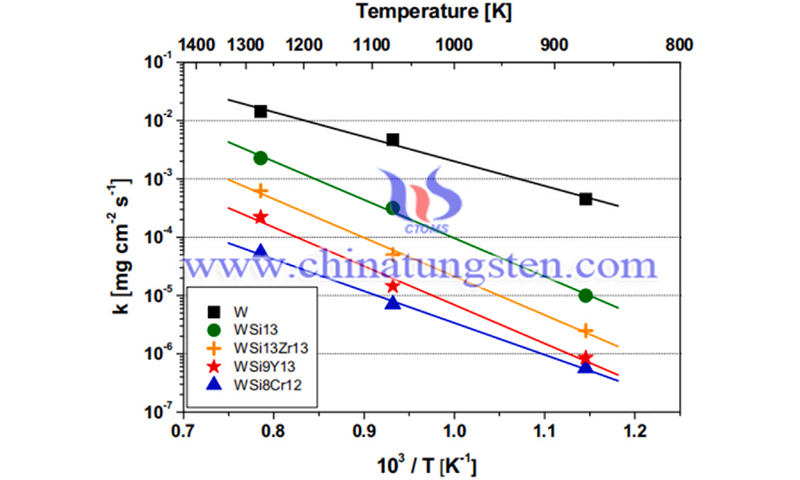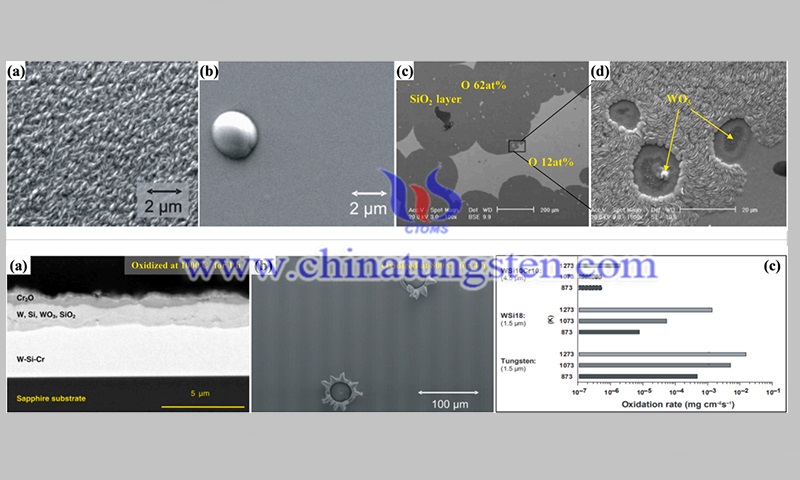Oxidation Behavior of W-Si Ternary Alloys
- Details
- Category: Tungsten's News
- Published on Friday, 21 April 2023 22:00
The W-Si ternary alloys own a longer oxidation life than W-Si binary alloys. The oxidation behavior of different ternary alloys is significantly lower compared to those of pure W and WSi13 alloys. In the temperature range of 600-1000°C, the oxidation rate of WSi13Zr13 alloy is only 0.16-0.27 times that of WSi13 alloy. the oxidation rate of W-Si-Cr alloy is lower than that of WSi9Y13 alloy, while the oxidation rates of WSi8Cr12 and WSi12Cr7 alloys at 1000°C are only 0.25 and 0.023 times that of WSi9Y13 alloy, respectively. 0.25 and 0.023 times, respectively.

The elements Si, Cr, Ti, Zr, Nb and Y have low neutron irradiation activation and stable thermodynamic properties and are widely used to improve the oxidation resistance of refractory metal alloys. These elements can be oxidized rapidly when a reactor de-cooling accident occurs and form a dense and continuous oxide film on the surface of W-based alloys, thus retarding further oxidation of W-based alloys.
Koch et al. investigated the oxidation characteristics of W-Si ternary alloys at a temperature of 1000°C. When the WSi12Cr7 alloy was oxidized at 1000°C for 1 h, the coating surface was covered with a continuous dense Cr2O3 layer, and the intermediate layer was mainly composed of W, Si, WO3 and SiO2 without Cr elements. The formation of oxide film effectively inhibits the oxidation of WSi12Cr7 alloy.
Therefore, the service life of the ternary alloy is longer than that of the binary alloy under high temperature and oxygen conditions. In addition, Cr content and oxide layer thickness have an important effect on the oxidation resistance of W-Si-Cr alloys. The surface of WSi10Cr10 alloy with a thickness of 2.5 μm showed bursting after oxidation at 800 °C for 4 h. However, the WSi10Cr10 alloy with a thickness of 4.5 μm maintained an intact surface structure after oxidation at 1000 °C for 22 h. The relatively high Cr content made it easier to form a dense Cr2O3 protective film on the surface during the oxidation process, and its oxidation rate was significantly lower than that of W and WSi18.

Reference: Fu T, Cui K, Zhang Y, et al. Oxidation protection of tungsten alloys for nuclear fusion applications: A comprehensive review[J]. Journal of Alloys and Compounds, 2021, 884: 161057.
- Tungsten Manufacturer & Supplier, Chinatungsten Online: www.chinatungsten.com
- Tungsten News & Prices of China Tungsten Industry Association: www.ctia.com.cn
- Molybdenum News & Price: news.molybdenum.com.cn
- Tel.: 86 592 5129696; Fax: 86 592 5129797; Email: sales@chinatungsten.com



 sales@chinatungsten.com
sales@chinatungsten.com